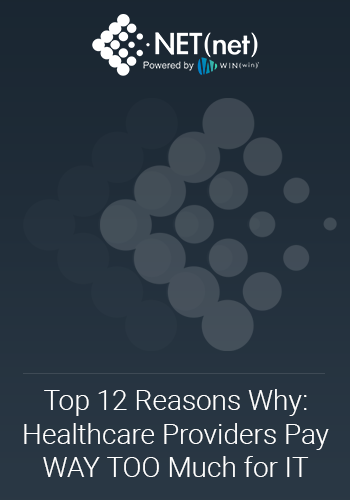Healthcare is one-fifth of the US economy. Due to the shifting demographics related to aging baby boomers, Medicare and Medicaid patients now make up roughly half the patient population. Due to changing insurance payout structures, this population of patients now costs hospitals roughly 10% more to serve than they make, leaving the remaining patients to make up the difference -- plus providing enough operating margin to sustain all investments.
In addition, of the 29 major industries we serve, Healthcare ranks 28th in IT Buying Efficiency, which is to say that Healthcare is the 2nd worst performing industry when it comes to technology purchases (only Government is worse (e.g., only government pays more than healthcare does for the very same technology hardware, software, and services all industries use to power their organizations)).
There are many reasons why this is the case, and we outline the Top 10 Reasons why Healthcare pays WAY TOO MUCH for IT in this whitepaper, updated in 2022 and available here.
Despite this, healthcare is somewhat insulated from its own inefficiency as well as from the negative macro-economic factors we are currently facing, largely due to its cost-plus model, where it simply passes on the costs of the service to the end customer – the patient. When it comes to life-saving procedures, patients do not usually haggle about the bill with a monopolistic supplier in a captive market (your local community hospital), and so health systems and major hospitals alike are often able to escape many of the financial pressures that plague for-profit businesses that are selling non-essential wares in competitive markets where there are many alternatives as well as ample price and delivery options.
However, the healthcare industry, like many other industries, is currently suffering from a confluence of factors that are increasing input costs at the same time revenue forecasts are softening. This is putting a double squeeze on healthcare clients like they have never experienced.
The rising costs of healthcare is an industry-wide problem making needed procedures seem unaffordable even for the well-insured. The 3 major contributing factors to this phenomenon are:
- Increasing Input Costs – regulatory compliance, drug manufacturing, insurance, staffing, and administrative costs have all spiked over recent years causing advanced healthcare to become a heavy cost burden for patients. Everything from CT/MRI scans, lab tests, even follow-up visits have increased significantly in cost.
- Covid-impacted Industry – resulted in patients that wanted to avoid hospitals, overworked doctors, a shortage of support workers, and a lack of facility availability, among other issues. This ‘hangover’ effect is still being felt well after the worst of the pandemic is over.
- See How: 75% of nurses are burned out.
- A Bad Economy – contributes to patients putting their health on hold, often delaying needed and even critical treatments, and in many cases significantly delaying or even eliminating preventative care measures that are simply viewed as unaffordable and/or not worth the risk.
This has put healthcare organizations in an unfamiliar position as they are scrambling (for the first time in the 20 years we have been serving this market) to find ways to cut costs, as prices are already sky high, and it does not seem practical to charge even more on a shrinking number of patients who are electing for a smaller number of procedures.
Healthcare Cost Savings Opportunity
Artificial Intelligence (AI) automating manual tasks to reduce paperwork has long been promised to be the panacea for overburdened doctors, nurses, and support staff, but with high profile failures such as the flame-out of IBM’s Watson Healthcare, the technology seems a bit long on promise and short on delivery to this point.
Some healthcare organizations are now scrambling for ways to save money, and they are frankly looking in the wrong areas. They are cutting staff and facility costs, as well as discretionary spending on third party providers and projects, but these reactionary measures are often not enough, and too often, they cut muscle and bone – rather than fat.
We are helping smart healthcare organizations look for ways to invest in information technology to not only transform their organizations to better enable processes through digitalization and modernization efforts, including adopting mobile healthcare solutions to improve patient care and reduce treatment costs, but to transform their IT costs as well.
Digital Transformation efforts can not only help to modernize healthcare organizations to address some of the strategic concerns they have about patient care, community health, and the social vitality and economic development of the areas in which they operate, but can also be transformative to the IT cost albatross, helping healthcare organizations find some relief from the punitive legacy IT cost structure that often enables them to increase operating margins to combat other strategic and financial concerns more effectively.
This can also work in reverse. Reviewing your IT cost structure can often illuminate ways in which organizations can get better, smarter, and faster, for significantly less than they are paying today.
We encourage:
- Healthcare CEOs concerned with community health, social vitality, and patient care
- Healthcare CFOs concerned with disproportionately large IT costs and
- Healthcare CIOs concerned with digital transformation efforts
Click here and contact us to learn how we may be able to help you make transformational changes that improve organizational value while helping you save between 16-48% on your major technology costs.
We have experience helping healthcare clients save money with all the major technology providers in hardware, software, services, cloud, integrators, and telecom (among other categories of IT spend) including, but not limited to:
- Hardware:
- Cisco
- Dell
- EMC
- Fujitsu
- Hitachi
- HP
- Huawei
- IBM
- Juniper
- Lenovo
- NEC
- NetApp
- Zebra
- Software:
- Adobe
- ADP
- Akamai
- Broadcom
- Cornerstone
- Citrix
- DocuSign
- IBM
- Kronos
- Lawson
- Microsoft
- Nutanix
- Okta
- Open Text
- Oracle
- Palo Alto
- Qualtrics
- Salesforce
- SAP
- SAS
- ServiceNow
- Slack
- Splunk
- Tableau
- Ultimate
- VMWare
- Workday
- Zoom
- Services:
- Accenture
- Bain & Company
- BearingPoint
- Boston Consulting Group
- Booz Allen Hamilton
- Capgemini
- Deloitte
- EY
- IBM
- KPMG
- McKinsey & Company
- Mercer
- OliverWyman
- Roland Berger
- PwC
- Cloud:
- AWS
- GCP
- Azure
- IBM
- Alibaba
- Oracle
- VMware
- Dell
- Integrators:
- Atos
- Cognizant
- HCL
- Infosys
- Kyndryl
- MuleSoft
- Tata Consultancy Services
- Wipro
- Telecom:
- AT&T
- Avaya
- BT
- Charter
- Cisco
- Comcast
- Deutsche Telekom
- Ericsson
- Huawei
- Nokia
- NTT
- Orange
- Qualcomm
- Sprint
- T-Mobile
- Telefonica
- Verizon
- Vodafone
- ZTE
As well as nearly 400 different technology vendors that specialize in healthcare IT including, but limited to:
| 3M | Advance MD | AGF Healthacre | Allscripts | AsSoftware |
| Athena Health | CareCloud | Cerner | ClearView | Documentium |
| DrChrono | eClinical Works | Epic Systems | Experien Health | FiServ |
| Intelisystems | Kaiser | Kareo | MAK-System | McKesson |
| Meditech | NetSuite | NexTech | NextGen | Philips |
| Practice Fusion | Optum Health | Quest Diagnostics | SCC | SCI |
| SDB | Siemens | T-Systems | Topaz Systems | Trans Union Healthcare |
| Virgin Pulse | Vizient | Waters | Waystar | WebMD |
| Web PT | West Corporation | XIFIN | Zen Healthcare IT | Intellichart |
| GE Healthcare | Greenway Health | Haemonics | Honeywell |
And many, many others:
| Allergy | Ambulatory | Anesthesiology | Billing and Invoicing | Blood Donor Management |
| Cardiovascular | Charts | Chromatography | Claims | Clinical |
| Chiropractic | Dental | Diabetes | EHR | Emergency |
| EMS | Endocrinology | Family Medicine | Gastroenterology | General Medicine |
| Genetic Medicine | Geriatric | Hematology | Hospice | ICU |
| Imaging | Immunology | Infectious Diseases | Insurance | Laboratory |
| Meaningful Use | Medical | Mental Health | Metabolism | Mobile Healthcare |
| Ophthalmology | Oral Surgery | Orthopedic | Otolaryngology | Outpatient |
| PACS | Palliative | Pathology | Patient Records | Pediatrics |
| Pharmacy | Rehabilitation | Practice Mgt | Psychiatry | Radiology |
| Scheduling | Surgery | Telemedicine | Time Tracking | Trauma Center |
| Urgent Care | Vascular | Workstations | x-Ray | Oncology |
| Neonatal Prenatal | Neurology | Neurosurgery | OBGYN |
NET(net) can help you minimize costs and risks, while maximizing the realization of value and benefit of all your technology agreements, investments, and relationships, so if you are looking to save money, improve operational efficiency, and/or modernize & improve your organization, Act Now.
Contact us today to learn more about how we can help you save on all your technology agreements or Sign up now for a Savings Cloud subscription, and we will get started right away.
About NET(net)
Founded in 2002, NET(net) is the world’s leading IT Investment Optimization firm, helping clients find, get, and keep more economic and strategic value in their technology supply chains. With over 2,500 clients around the world in nearly all industries and geographies, and with the experience of over 25,000 field engagements with over 250 technology suppliers in XaaS, Cloud, Hardware, Software, Services, Healthcare, Outsourcing, Infrastructure, Telecommunications, and other areas of IT spend, NET(net) has the expertise you need, the experience you want, and delivers the performance you demand, resulting in incremental client captured value in excess of $250 billion since 2002. Contact us today at info@netnetweb.com, visit us online at www.netnetweb.com, or call us at +1-616-546-3100 to see if we can help you capture more value in your IT investments, agreements, and relationships.
NET(net)’s Website/Blogs/Articles and other content is subject to NET(net)’s legal terms offered for general information purposes only, and while NET(net) may offer views and opinions regarding the subject matter, such views and opinions are not intended to malign or disparage any other company or other individual or group.

















